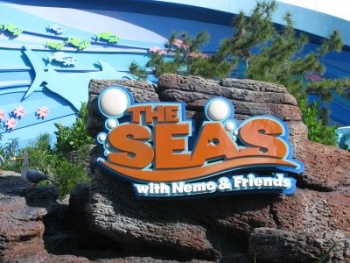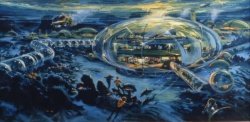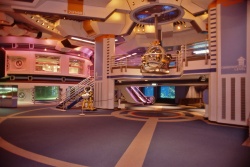Difference between revisions of "The Seas with Nemo & Friends"
m (→Consultants) |
(→Fun Facts and Trivia) |
||
| Line 82: | Line 82: | ||
* Montgomery Watson was the prime architectural and engineering contractor for The Living Seas pavilion. | * Montgomery Watson was the prime architectural and engineering contractor for The Living Seas pavilion. | ||
| + | * The gravel floor in the Caribbean Coral Reef aquarium was replaced for the first time in 1998. | ||
===Consultants=== | ===Consultants=== | ||
Consultants that helped in the creation of The Living Seas included: | Consultants that helped in the creation of The Living Seas included: | ||
Revision as of 13:27, 24 April 2014
The Seas With Nemo &Friends is a pavilion within Future World in Epcot. If you are looking for the attraction located within the pavilion please see The Seas with Nemo & Friends (Attraction)
Contents
Pavilion History
Development and Construction
Although The Living Seas was originally planned as an opening day pavilion for EPCOT Center, the pavilion did not open until 1986. Part of the delay, was the fact that both the design and tone of The Living Seas changed drastically during this time. The original concepts for the pavilion were more fantasy based then scientific, with one of the early ideas for an attraction within the pavilion allowing guests to “Board the clipper ship ‘Spirit of Mankind’ to sail through moments of peril and triumph with seven legendary mariners, the great explorers who charted the seas for civilization”. Another early concept would have begun with guests entering The Living Seas and seeing a preshow where the Greek god Poseidon would calm a raging storm. After the preshow, Poseidon would have narrated guests on their dark ride adventure. This dark ride would have been a fully immersive experience, with shark attacks, shipwrecks, and various special effects adding to the excitement, before guests eventually entered the pavilion’s 200 ft. tank at the rides conclusion. Following the dark ride, guests would have arrived at Sea Base Alpha- an underwater research facility. According to the 1982 book EPCOT Center: Creating the World of Tomorrow, while in The Living Seas ride guests would see:
The environment, designed to look like a futuristic sea base, is an actual working environment in which man and machine coexist with the sea and its original inhabitants. All around us, we see diver’s carrying on their tasks, often accompanied by their coworkers, the dolphins, trained to work alongside man.— EPCOT Center: Creating the World of Tomorrow
Inside of Sea base Alpha, guests could see a "television" system that allowed them to follow various divers’ activities. One camera would be set on the sea floor, the second mounted on a robotic device which followed the diver, and finally, one would be on the diver’s helmet itself. In the research facility, guests would also be able to see a series of exhibits that not only showcased underwater life, but also the future of underwater science. Unlike its successor, the original plans for The Living Seas pavilion’s architecture called for a two story pavilion, with a glass roof. As designs for the pavilion changed, and the entire Living Seas took on a more serious tone, the glass ceiling was replaced by a conventional one.
Due to this change in tone as well as logistical issues, construction on The Living Seas was pushed back. In 1980, plans for The Living Seas called for both an extensive dark ride, titled "The World of the Sea” which would have allowed guests to enter “bubble-like vehicles” to experience various dramatic ocean scenes, and the elaborate Sea Base Alpha. Eventually however, either due to a change in tone, or United Technologies’ (the pavilion’s sponsor) unwillingness to fund the elaborate pavilion, the layout of The Living Seas was altered before construction. Instead of the elaborate dark ride that would have led guests to Sea Base Alpha, a preshow video and short trip through the aquarium were instead installed. The pavilion was now designed to essentially be two parts, the large Coral Reef tank, and Sea Base Alpha- where guests could look at the future of underwater research. After a series of setbacks, construction on The Living Seas began in March of 1984, and the pavilion opened to the public on January 15, 1986.
The Living Seas Presented By United Technologies (1986-1998)
When The Living Seas opened, it featured three connected attractions, and the Coral Reef Restaurant. After winding their way through the queue (where guests could see historical artifacts from the history of sea exploration), guests watched a short film called The Seas. This movie, showed how water made life possible on earth, and also how our understanding of the seas have developed. After watching the short film, guests entered the hydrolators, which were elevators that took guests "down" to the ocean floor (although in actuality they did not move anywhere), before they were loaded into their Sea Cabs for the Caribbean Coral Reef Ride. The Caribbean Coral Reef Ride took guests through the ocean's depths (the Coral Reef Tank) in omnimover fashion, to Sea Base Alpha. Once at Sea Base Alpha, guests could explore various interactive exhibits that allowed them to learn about marine life, and the technology that makes underwater research possible. From Sea Base Alpha, guests could also look out into the various tanks. After exploring Sea Base Alpha, guests could enter another set of hydrolators and exit the pavilion.
The Living Seas (1998-2006)
Aside from minor changes to Sea Base Alpha, The Living Seas remained essentially unchanged until 1998 when United Technologies ended their sponsorship of the pavilion. With the end of United Technologies sponsorship, all references to the company were removed from the pavilion by the end of 1999. At this time, one of the two preshow theaters was also closed, in order to allow returning guests to skip the film altogether and move directly to the hydrolators. Subsequently, in 2002 the Sea Cab portion of the pavilion closed, with guests now walking from the Hydrolators, past the non-functioning Sea Cabs, and into Sea Base Alpha (of note is the fact that the SeaCabs remained intact after being discontinued, they were just boarded up). With no sponsor, and a decrease in popularity, Disney decided that The Living Seas needed a new tone. In order to increase the pavilion’s popularity, Disney began to tie the popular 2003 film Finding Nemo into the exhibits in Sea Base Alpha. As part of this new tie in, in 2004 Modules 1C and 1D were closed to the public. When they reopened, the featured Bruce’s Shark World (in 1D) and a new attraction Talk with Crush (in 1C). Turtle Talk With Crush was an interactive show that featured Disney's newest technology, "digital puppetry"- which allowed guests to talk and interact with Crush the turtle from Finding Nemo. The new show proved to be extremely popular, quickly becoming the biggest draw in The Living Seas pavilion, and causing Sea Base Alpha to be overwhelmed by the crowds. Due to this unexpected popularity, Disney decided to rethemed the entire Living Seas pavilion, and on August 21, 2005 the pavilion was closed.
The Seas with Nemo & Friends (2006-Present)
On November 23, 2005, the Sea Base Alpha half of the Seas pavilion reopened. During the refurbishment, the exit hydrolators were removed from the pavilion, and guests now (temporarily) entered and exited through large glass doors. The Sea Base (as it was now called) had been completely remodeled. New signs and decor were added, and the previously scientific exhibits were replaced by Finding Nemo themed ones. Although Sea Base (and thus Turtle Talk with Crush) was operational by November, the front half of the pavilion remained closed. During this time, the preshow theater, hydrolators, and former Sea Cab area were removed, so that the dark ride portion of the pavilion could be expanded. In the place of the old preshow, hydrolators, and Sea Cabs ride, Disney planned on creating a new dark ride also titled The Seas with Nemo & Friends, which would allow guests to follow Nemo’s adventures in the ocean, after once again being separated from his father. In total, 9 new dark ride sets and 280 feet of extra track were added to the old Sea Cab track in order to create the new attraction. To go along with the new track, side facing "Clamobiles" (the dark ride's vehicles) were added. The reason for that the vehicles were side facing, was that Disney had developed a new technology that allowed them to project the characters from Finding Nemo into the large aquarium tank. During the refurbishment Disney also remodeled the pavilion's queue, so that guests now walked directly to the loading area for the dark ride. The new queue was themed so that guests would travel from the beach, to under the pier, to underwater. By doing this, Disney eliminated the need for the hydrolators, but retained the original story that they told.
Finally, on October 10, 2006 the construction walls came down, before the rest of the pavilion opened to the public on October 19th. The Seas with Nemo & Friends now features a substantial dark ride (also named the Seas with Nemo & Friends) to go along with Turtle Talk with Crush and the rest of the Sea Base. With the Seas with Nemo & Friends operational, there was still one final step to the Seas’ overall. On January 29th 2007 Turtle Talk with Crush closed. The popular attraction was then moved from module 1C to the larger module 1A. A corridor was then built to connect the module to the old preshow theater #2, allowing Turtle Talk to have a much higher capacity.
Current Attractions
The Seas with Nemo & Friends (Attraction)- This dark ride allows guests to explore the "Big Blue World" with Nemo and his friends. On The Seas with Nemo & Friends, guests board Clamobiles and set off to help rescue Nemo who is once again missing. The Seas with Nemo & Friends is based on the 2003 Disney-Pixar movie Finding Nemo.
Turtle Talk with Crush- This interactive show allows guests to meet and talk to Crush himself. Turtle Talk with Crush uses digital puppetry to help Crush (from Finding Nemo) answer guests questions.
Sea Base- This interactive area allows guests to further explore the seas. Here, guests can look out in the aquariums, and learn more from various Finding Nemo themed interactive exhibits.
Tours
The Seas with Nemo & Friends features three different tours that guests can experience (for an additional cost:
Epcot DiveQuest- Epcot DiveQuest is 3 hour experience that certified SCUBA divers can take. The experience is broken up into three parts, a 40 minute under water tour in the Caribbean Coral Reef, a backstage tour, and free time. Guests must be at least 10 years old to participate in Epcot DiveQuest
Seas Aqua Tour- This tour allows guests to swim in the Caribbean Coral Reef Aquarium with the assistance of a SCUBA Assisted Snorkel system. The tour last approximately two and half hours, and guests must be at least 8 years old to participate.
Dolphins in Depth- This three hour tour allows guests to learn about, meet, and even swim with the dolphins. Guests must at least 13 years old, but do not need to know how to swim to participate. Only one group of up to 8 guests can participate in the Dolphins in Depth experience per day.
Former Attractions
Originally, The Living Seas featured three separate but interconnected attractions. The attractions formally located in the pavilion included:
Seas- This short video explained to guests how the Earth changed from a volcanic planet, to one covered in oceans. The Seas film played from 1986 until 2005.
Caribbean Coral Reef- The short omnimover attraction allowed guests to board SeaCabs and take a ride through Caribbean Coral Reef Aquarium to Sea Base Alpha. While on board the ride vehicles, guests could get a 270 degree view of the large aquarium. The Caribbean Coral Reef ride closed to guests in 2001. Following their closure, guests simply walked down a corridor to Sea Base Alpha.
Sea Base Alpha-Sea Base Alpha featured many scientific exhibits related to underwater research. related exhibits. Although the exhibits changed over time, they always had a marine focus. From Sea Base Alpha, guests could look out into the pavilion's aquariums and see many exotic marine animals. Sea Base Alpha was open from 1986-2005. At this time, the area was renamed simply Sea Base, and the exhibits housed within were given a Finding Nemo Theme.
Restaurants
Coral Reef Restaurant- The Coral Reef Restaurant is a table service restaurant which specializes in seafood. The restaurant is located to the right of the entrance to The Seas with Nemo & Friends (Attraction). Inside, guests can look out into the Caribbean Coral Reef aquarium and observe over 4000 sea creatures.
Shopping
The Seas with Nemo & Friends Gift Shop- The pavilion's gift shop is located near in the Sea Base, near the exit. The shop sells Finding Nemo and aquatic merchandise, as well as general Epcot souvenirs.
Fun Facts and Trivia
- There are 61 different windows through which guests can view the Caribbean Coral Reef aquarium.
- Spaceship Earth could fit completely inside the aquarium.
- Many of the interior pipes in the Seas With Nemo & Friends have the name and extension number of Imagineers who worked on the attraction.
- Montgomery Watson was the prime architectural and engineering contractor for The Living Seas pavilion.
- The gravel floor in the Caribbean Coral Reef aquarium was replaced for the first time in 1998.
Consultants
Consultants that helped in the creation of The Living Seas included:
| Consultant | Credentials |
| Dr. Robert Ballard | Senior scientist at the Woods Hole Oceanographic Institution |
| Dr. Sylvia Earle | Vice President of Ocean Engineering, Inc. |
| Gilbert Grosvenor | President of the National Geographic Society. |
| Dr. Murray Newman | Director of the Vancouver Public Aquarium |
| Professor William Nierenberg | Director of the Scripps Institution of Oceanography |
| Dr. David Potter | Vice President of public affairs, General Motors. |
| Dr. John Ryther | Director of the Division of Applied Biology at Harbor Branch Foundation, Inc. |
| Robert Wildman | Deputy Director of the NOAA, Office of Sea Grants Program. |
References
http://www.intercot.com/edc/LivingSeas/index.html
http://www.lostepcot.com/livingseas.html
http://allears.net/tp/ep/e_seas.htm
http://disneyworld.disney.go.com/tours-and-experiences/epcot-dive-quest/
http://disneyworld.disney.go.com/tours-and-experiences/dolphins-in-depth/
http://disneyworld.disney.go.com/tours-and-experiences/seas-aqua-tour/


